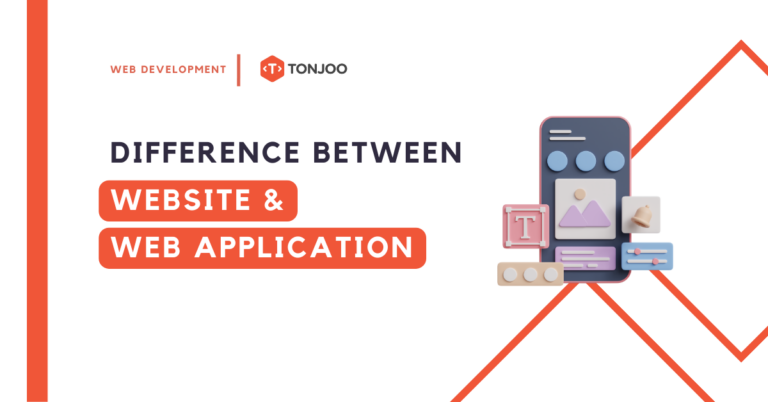
They are similar, but there is a difference between Website and Web Application. We often use the terms “website” and “web application” interchangeably, but the truth is, they’re not quite the same thing.
While both allow us to access information and interact with digital content, they have important differences.
By understanding the unique characteristics of each. You can determine which one is right for your needs.
So let’s dive in and explore the differences that make a website become a web app.
Table of Contents
What Is the Difference Between a Website and Web Application?
Website – For Delivering Content
When surfing the internet, we may come across various types of websites. You are now opening a website too. But, what is website?
A website is a collection of web pages that are interconnected and accessible via the internet that is hosted on a server. You can access it by using a web browser and typing its domain, like indiatimes.com or tonjoo.com.
These websites are hosted through a server that is always online, so you can access them anytime.
Compared to a web app, an essential website has these characteristics.
- Typically consists of static content that is intended for public consumption.
- Users can navigate through different pages but generally have limited interaction with the content.
- Commonly used for information dissemination, e-commerce, blogging, and other types of content sharing.
The characteristics of a website, such as its static content and limited interactivity, play a crucial role in determining its typical use cases. Here are some of its typical uses cases
- Personal blogs
- News websites
- Static E-commerce sites
- Corporate websites
- knowledge base
- support centre
Although typically, those are just regular websites, when strapped with applications, these websites will become web apps.
Web Apps – Website With More Functionality
What is a web application? Most people nowadays actually are already using the web app.
A web application, or “web app,” is a software program that runs on a web server and is accessed through a web browser.
This software program offers more functionality than a regular website. There are some characteristics of a web app.
- Typically involves dynamic content
- It allows for greater interaction and engagement than a website
- It often requires user authentication
These defining characteristics of web applications, such as their dynamic content and interactive features, can be observed in various examples.
- E-Commerce with checkout page
- Social media platforms
- Online marketplaces
- Collaboration tools
- Online banking platforms
- Travel booking sites
Website vs Web Application – Keys Differences
While websites and web applications share some similarities, several key differences set them apart. Understanding these differences is essential for businesses and organizations wanting to create an online presence that meets their needs.
1. Functionality
Websites are primarily designed to deliver content to users. They are often used for sharing information, showcasing products or services, and building an online presence for a business or organization.
Web applications, on the other hand, are designed for accomplishing specific tasks. They often involve advanced functionality such as user authentication, personalized content, and real-time communication.
2. User Interaction:
Websites typically have limited interactivity, with users consuming content rather than actively participating. On the other hand, web applications allow for more significant user interaction, often featuring forms, databases, and other interactive elements that facilitate communication and data exchange.
3. Data Management:
Websites generally involve minimal data management, with data typically being collected through forms or surveys. Web applications often require more sophisticated data management capabilities, such as storing and retrieving large amounts of data from databases.
4. Performance:
Websites typically have faster load times and require less processing power, as they generally involve fewer server-side computations. Web applications may require more server resources, often involving complex computations, database queries, and other resource-intensive tasks.
5. Development Process:
Website development typically involves creating static web pages using essential WordPress CMS, which a front-end web developer can do.
Web application development involves more complex software development. While web developers can use Customized WordPress CMS, other frameworks like Django and Laravel are also common.
Web application development may require a full-stack developer with experience in both front-end and back-end development.
In summary, websites are primarily designed for delivering content, while web applications are designed for interactivity and accomplishing specific tasks. Web applications often involve advanced functionality, more significant user interaction, more sophisticated data management, and more resource-intensive tasks than websites.
Web application development also typically involves more complex software development than website development. By understanding these differences, businesses and organizations can decide which type of online presence best suits their needs.
Common Web App Functionality
The main difference between an essential website with a web app is its functionality. Here are some basic Web App functionality that often incorporated into a web app
1. Web Portal
A web portal is a website that acts as a central hub or gateway to access various resources and services. It provides users with a single access point to information, applications, and other online resources.
Web portals can be designed for different audiences, such as employees, customers, or partners, and may include features such as personalized content, user authentication, and communication tools.
2. Dynamic Web Content
Dynamic web content refers to web content that changes based on user input or other factors, such as time of day or location.
The use of dynamic web content can enhance the user experience by providing more relevant and engaging content and can also enable businesses and organizations to target their audiences better and achieve their specific goals.
3. Check Out Page
The checkout page is a crucial component of an e-commerce website that enables customers to complete their purchases. It typically includes a summary of the items in the cart, shipping and payment options.
An effective checkout page should be user-friendly, secure, and easy to navigate, to ensure a smooth and seamless purchasing experience for the customer.
4. Inventory System
An inventory system is a software application that helps businesses manage inventory levels, track stock movements, and optimize their supply chain.
It provides real-time visibility into inventory levels, stock movements, and product availability, which enables businesses to make informed decisions about purchasing, production, and order fulfilment. An effective inventory system can help enterprises to reduce waste, avoid stockouts, and improve their overall supply chain efficiency.
Overall, these three topics are important aspects of web development that play a critical role in delivering a seamless and practical online experience for users.
By understanding the unique qualities and requirements of web portals, checkout pages, and inventory systems, businesses and organizations can make informed decisions about optimising their online presence and achieving their specific goals.
Web App vs Website – What do you need?
When creating an online presence, businesses and organizations often face the question of whether they need a website or a web application.
While both can effectively achieve specific goals, choosing the right one for your needs can make a significant difference.
Here are some factors to consider:
1. Goal
If your goal is simply delivering content to your users, a website may be the right choice. Like a static company profile website. This kind of website provides fixed content that rarely changes and typically requires minimal maintenance.
On the other hand, if you want to provide advanced functionality, such as user authentication, personalized content, and real-time communication, a web application is the way to go.
2. User Interaction:
A web application is the better choice if you want to provide a more interactive experience for your users. Let’s say, you want to add a customer service functionality; you need the help of a web app developer to add that to your website. On
Websites, on the other hand, are primarily designed for users to consume content rather than actively participate.
3. Development Process:
Website development is generally more straightforward and involves creating static web pages using HTML, CSS, and JavaScript.
On the other hand, Web App Development often takes more time and costs more due to its complex functionality, data management, and ongoing maintenance requirements.
However, the investment in a web application can be worthwhile for businesses and organizations that require advanced features and interactivity, while website development may be sufficient for those that simply need to deliver content to users.
4. Maintenance
Web applications require ongoing maintenance and updates to ensure that they function correctly and provide a positive user experience. This is because web applications often involve complex functionality and data management.
In contrast, websites require less maintenance than web applications, as they typically involve fewer complex functionalities and data management capabilities.
In summary, choosing between a website and a web application depends on your specific goals and requirements. If you simply need to deliver content to your users, a website may be the way to go.
However, a web application may be the better choice if you want to provide advanced functionality, user interaction, and sophisticated data management capabilities. The development process for web applications is more complex and requires more resources.
So, evaluate your needs and resources before making a decision.
Conclusion
Now you know which one is an essential Website or a Web App.
Choosing between a website and a web application can be challenging. By knowing the difference, now you know which one is suitable.
If you are looking to build a custom online presence that provides advanced functionality, greater user interaction, and sophisticated data management, you may want to consider partnering with a reputable web design and development company in India like Tonjoo.
At Tonjoo, we specialize in developing high-quality websites and web applications that are tailored to your unique needs and goals.
Our team of experienced developers and designers can help you create an online presence that stands out from the competition and meets the specific needs of your business or organization.
We take pride in providing our clients with personalized service and exceptional quality, and we are committed to ensuring that every project we undertake is a success.
Whether you need a simple website or a complex web application, we have the expertise and resources to deliver results.
Contact us today to learn more about how we can help you achieve your online goals and take your business or organization to the next level.
Updated on December 1, 2023 by Admin Tonjoo


